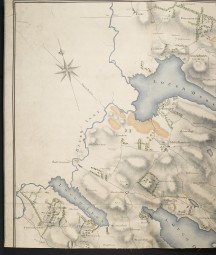by Aoife O’Connell, Catalogue Development Student
The National Library of Ireland holds a number of historically valuable and interesting photographic collections. Perhaps the best known and most utilised of these over the years since its acquisition has been the Lawrence Collection. It was acquired in 1943 for the then huge sum of £300. The popularity of the collection is a testament to the quality and value of the images. Here in the Information Systems department of the Library, great work has been going on behind the scenes as we endeavour to bring as much of the Library’s wonderful collections to as wide an audience as possible, by making them available to search in new and improved ways. The most recent result of these endeavours is the replacement of approximately 23,000 Lawrence Collection records on our online catalogue with new records containing extra information and features, and the addition of 14,500 new catalogue records that were never online before. These new catalogue records relate to the Lawrence Imperial and New Series (though the images have yet to be digitised).
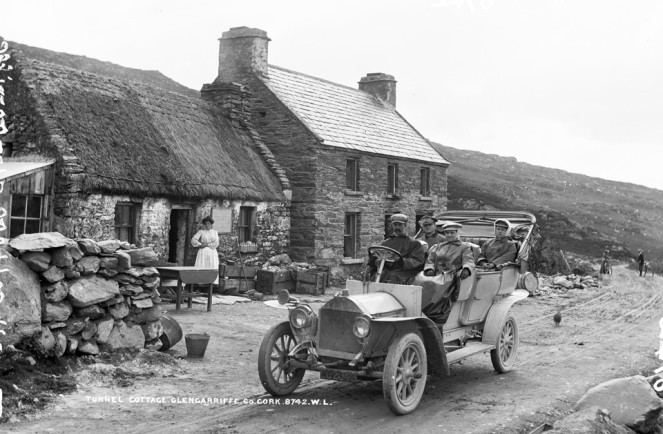
From our Lawrence Cabinet photographs - Tourists motoring past Long Tunnel Cottage, Glengariff, Co. Cork, circa 1906/07. NLI ref. LCAB 08742
The National Library’s Lawrence Collection consists of approximately 40,000 photographic glass plate negatives generated by the Lawrence photographic studios of Dublin, largely for tourist markets. They range in date from 1865 to 1914 and are divided into three distinct sections based on size: there are 4,500 Imperial plates (12” x 10”), 10,000 Cabinet plates (7.5” x 5”), and 13,000 Royal plates (8.5” x 6.5”). There are also about 10,000 Lawrence New Series negatives, which are an assortment of all three plate sizes and were images rejected by Lawrence for being imperfect. These photographs consist mainly of topographical views of Ireland, including almost every small town and village in the country, and often including people and activities. However, political events were generally not photographed. There are also some interior views, including here at the National Library! Most of our Lawrence images were photographed by the Dublin photographer, Robert French (1841-1917), between 1870 and 1914.
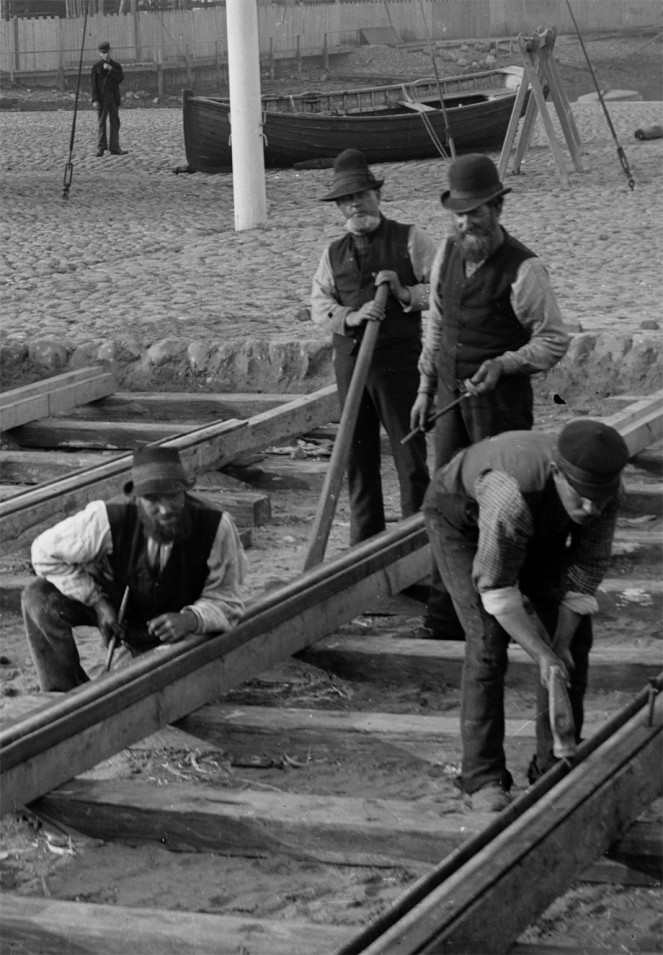
Detail from one of our Lawrence Royal photographs - Men working at Belfast Docks laying a baulk road for the internal dock railway, circa 1890. NLI ref. LROY 02383
Up until now, the Lawrence Imperial or New Series images were not searchable on our online catalogue. And though the Lawrence Royal and Cabinet photographic negatives were searchable online (along with digital images), these records, which drew on information contained in the Lawrence Day Book, were quite basic. Furthermore, it wasn’t possible for library staff to edit the records when new information became available. Now that we have added these 40,000 catalogue records however, the whole of this fantastic collection is now available to library users and people all over the world for online searches. Extra information has been added to improve the records, and library staff can now easily update the records! So how did we do it?
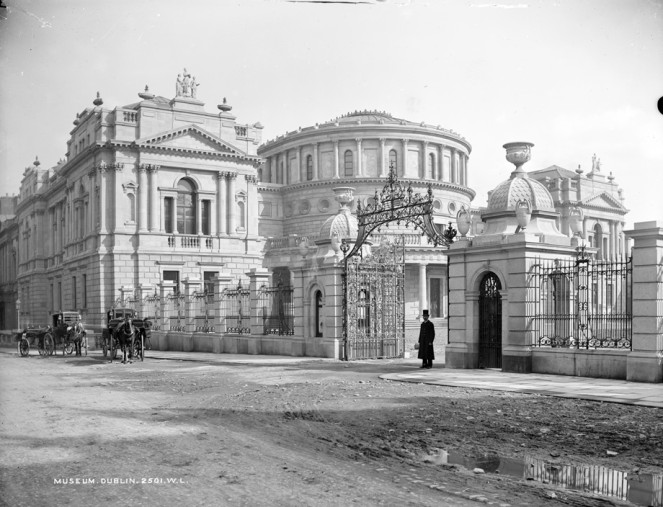
We even appear in the Lawrence Collection, complete with carriages and a fairly sizeable pothole, 1890s. NLI ref. LROY 2501
Rather than create a single catalogue record for every individual glass plate in the collection (which would have been laborious and taken a very long time!), we took a different approach. We decided to work with a database that already existed in the Library and map the information contained in it onto Virtua, our Library Management System. This method was also used recently to catalogue the O’Dea Photograph Collection and the Longfield Map Collection, and will also be used to make the Eason, Valentine, Cardall, Stereo Pairs and Eblana Photograph Collections available in the coming months.
Of course, this process wasn’t entirely straightforward. The data contained in the Lawrence Collection database (thanks to the great work of Glynis Pickett and Joanna Murphy!) formed the essential foundation for our work, however it was not suitable for mapping to our Virtua LMS straight away. We built on this work and using Google Refine (a free open source software tool), we were able to clean up the data and make it usable for our purposes with (relative!) ease.
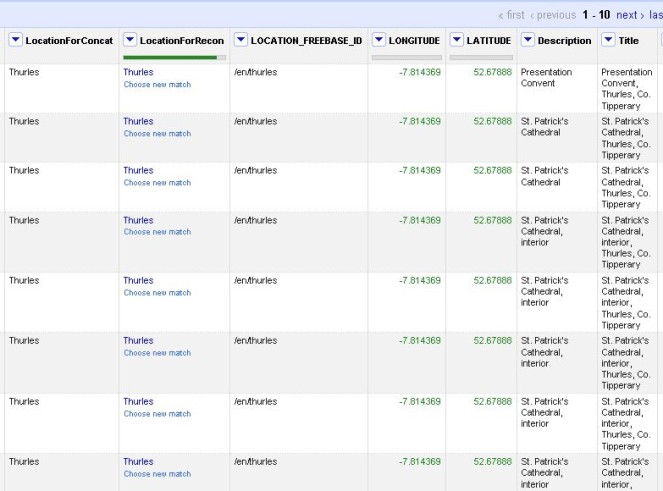
Google Refine in action on our Lawrence Collection database
Google Refine is a great tool that makes it very easy to work with large amounts of data:
- We used it to standardise the terminology and locations recorded in the Lawrence database in order to add extra information to the titles and add subject headings to each record. This means that any catalogue search will return comprehensive and accurate results.
- We also used Google Refine to create new columns in the database that would be more appropriate for cataloguing and we moved data around these columns to maximise its usefulness.
- Another great aspect of Google Refine is the function that allows you to expand your existing data by adding information from other databases, like Freebase. We used this function to add latitudes and longitudes to our records based on the locations already recorded in the database. So now, the majority of the Lawrence Collection catalogue records also contain a map view, pin-pointing on a map the spot where the photo was taken!

Explore clusters of Lawrence Collection photos taken all over Ireland in our Map View - 10 in Athenry, 285 in Athlone, while Dublin is hidden under the weight of photos...
These new catalogue records are rich, accurate and full of information. In terms of accessibility, they are an invaluable addition to the Library’s online catalogue. They can now be amended by library staff, so as new information comes to light (e.g. from our excellent Flickr users), it can be easily added to the catalogue further enhancing each record. Why don’t you take some time to search for your own hometown and see what has changed in the last hundred or so years! Or just browse the whole collection in our catalogue by searching for William Lawrence and filtering your search by photos. Several hundred Lawrence Collection photos are also on Flickr, so whenever you see the Flickr symbol on these records, click to find a wealth of extra information and great conversations!
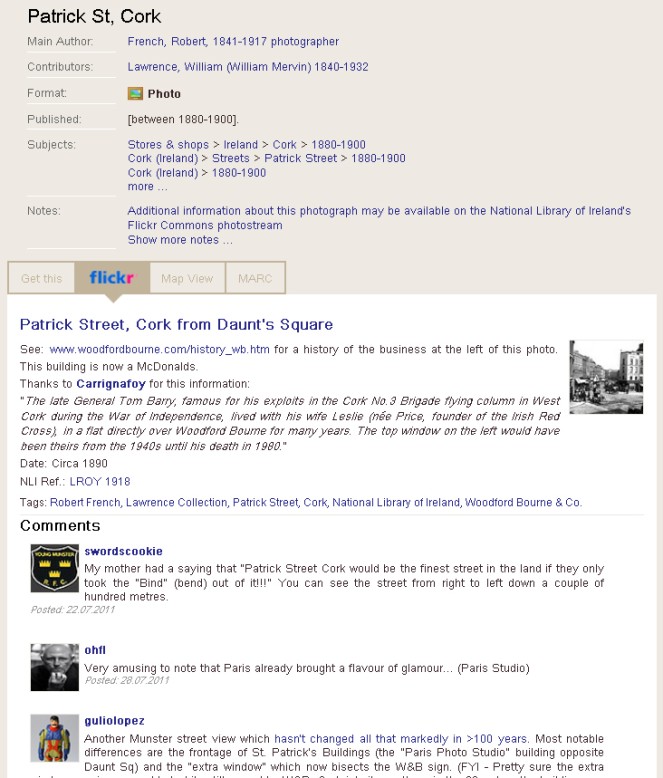
Thanks to the amazing work on an integrated Flickr API undertaken by our Software Development Student, Lutz Biedinger, all of the comments, tags and additional information on our photos that are contributed by our Flickr users are now integrated straight into our catalogue
And keep an eye out for an upcoming blog post about a volunteer project that is underway here at the Library, involving the cataloguing of two collections with close links to the Lawrence Collection, the Lawrence Photographic Project 1990/91 and Our Own Place.
